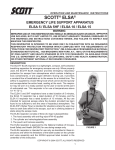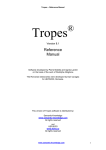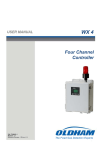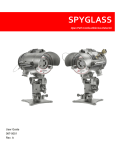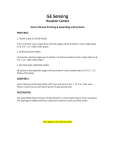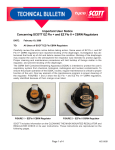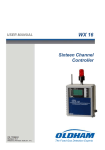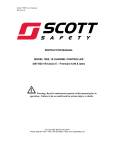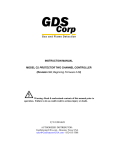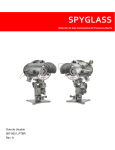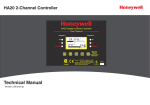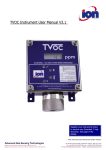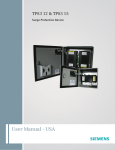Download 7400 Plus - User Manual
Transcript
Instruction Manual 7400 Plus Four Channel Controller WARNING READ AND FOLLOW THE ENTIRE CONTENT OF THIS MANUAL PRIOR TO USE. FAILURE TO DO SO MAY RESULT IN SERIOUS INJURY OR DEATH. COPYRIGHT © 2012, SCOTT, ALL RIGHTS RESERVED 087-0041 Rev. B 7400 Plus Instruction Manual This Page Left Intentionally Blank ii 087-0041 Rev B 7400 Plus Instruction Manual Table of Contents 1. Safety and General Information .................................................................... 1 1.1. 1.2. 1.3. 1.3.1. 1.4. 1.5. 1.5.1. 1.6. 2. Introduction ................................................................................................... 7 2.1. 2.1.1. 2.1.2. 2.1.3. 2.1.3.1. 2.1.3.2. 2.1.3.2.1. 2.1.4. 2.1.5. 2.1.6. 2.2. 2.3. 3. Physical Components .......................................................................... 7 Motherboard ......................................................................................... 9 Internal Display Assembly .................................................................. 12 Input Options ...................................................................................... 13 Analog Input Option ........................................................................... 13 Bridge Sensor Input Option ................................................................ 14 Cat Bead Sensor Input Wiring Diagrams....................................... 16 4-20 mA Analog Output Option .......................................................... 18 Discrete Relay Option ........................................................................ 18 MODBUS RS-232/RS-485 Interface Option ....................................... 19 Using the Keypad ............................................................................... 21 Specifications ..................................................................................... 22 Physical Installation..................................................................................... 24 3.1. 3.2. 3.2.1. 3.3. 3.3.1. 3.3.2. 3.4. 3.5. 3.6. 3.7. 3.7.1. 3.7.2. 4. Important Notices ................................................................................. 1 Certifications and Approvals................................................................. 1 Warnings, Cautions, and Notes............................................................ 2 General Warnings and Cautions .......................................................... 2 General Rules of Use ........................................................................... 3 Warranty............................................................................................... 4 Contacting Scott Health & Safety ......................................................... 4 Acronyms Quick Reference.................................................................. 5 Installation Considerations ................................................................. 24 Mounting the 7400 Plus ..................................................................... 24 Optional NEMA 7 Explosion Proof Enclosure..................................... 25 Electrical Configurations..................................................................... 26 Electrical Codes ................................................................................. 26 Optional External Power Supply......................................................... 26 Evaluating Wire Length and Size ....................................................... 27 Sensor Head Wiring ........................................................................... 28 Cat Bead Sensor Initial Setup ............................................................ 29 Calibration .......................................................................................... 35 Determining Span Gas to Use............................................................ 37 Sensor Calibration Procedure ............................................................ 37 Operation .................................................................................................... 40 iii 087-0041 Rev B 7400 Plus Instruction Manual 4.1. 4.2. 4.2.1. 4.2.2. 4.2.3. 4.3. 4.3.1. 4.3.2. 4.3.2.1. 4.3.2.2. 4.3.3. 4.3.4. 4.4. 4.4.1. 4.4.1.1. 4.4.1.2. 4.4.1.3. 4.4.1.4. 4.4.2. 4.4.3. 5. 5.1. 5.2. Menu Structure................................................................................... 40 Data Display Screens ......................................................................... 41 Engineering Unit Screen .................................................................... 41 Bar Graph Screen .............................................................................. 41 Trend Screen ..................................................................................... 41 Channel Setup Menus ........................................................................ 41 Setup Menu ........................................................................................ 42 Channel Setup Entry Menu ................................................................ 42 Fault Menu ......................................................................................... 42 Alarm Menu ........................................................................................ 43 Channel Configure Menu ................................................................... 43 Cal Setup Menu ................................................................................. 44 System Configuration Menus ............................................................. 45 System Setup Menu ........................................................................... 46 Relay Setup Menu .............................................................................. 46 Clock/Delays Menu ............................................................................ 46 Analog Setup Menu ............................................................................ 47 Horn/Acknowledge Menu ................................................................... 47 System Security Menu ....................................................................... 47 History Log ......................................................................................... 48 Parts List and Maintenance ......................................................................... 50 Parts List ............................................................................................ 50 Scott Repairs...................................................................................... 50 Appendix-MODBUS Register and Function Code Summary .............................. 52 iv 087-0041 Rev B 7400 Plus Instruction Manual List of Figures Figure 2-1. Figure 2-2. Figure 2-3. Figure 2-4. Figure 2-5. Figure 2-6. Figure 2-7. Figure 2-8. Figure 2-9. Figure 2-10. Figure 2-11. Figure 2-12. Figure 3-1. Figure 3-2. Figure 3-3. Figure 3-4. Figure 3-5. Figure 3-6. Figure 3-7. Figure 3-8. Figure 3-9. Figure 4-1. Figure 4-2. Figure 4-3. Figure 4-4. External Display ....................................................................................... 8 Motherboard ........................................................................................... 10 Power Distribution .................................................................................. 11 Internal Display Assembly ...................................................................... 12 Analog Input PCBA ................................................................................ 13 External Transmitter Wiring .................................................................... 14 Bridge Sensor Input PCBA ..................................................................... 15 2-Wire Transmitter (Typical) to Bridge Sensor Input PCB ...................... 16 3-Wire Transmitter (Typical) to Bridge Sensor Input PCB ...................... 17 4-20mA Analog Output PCBA ................................................................ 18 Discrete Relay PCB ................................................................................ 19 MODBUS Interface PCBA ...................................................................... 20 Mounting Dimensions ............................................................................. 24 NEMA 7 Enclosure ................................................................................. 25 Sensor Voltage Adjustment .................................................................... 29 Cat Bead Sensor Wiring to Bridge Sensor Input PCB ............................ 31 Sensor Voltage Measurement ................................................................ 32 Zero Balance .......................................................................................... 33 Balance Adjustment ............................................................................... 34 Typical Calibration Setup ....................................................................... 36 Calibration Quick Guide ......................................................................... 38 Menu Structure of the 7400 Plus ............................................................ 40 Data Display Screens ............................................................................. 41 Channel Setup Menu.............................................................................. 42 System Configuration Menus ................................................................. 45 v 087-0041 Rev B 7400 Plus Instruction Manual This Page Left Intentionally Blank vi 087-0041 Rev B 7400 Plus Instruction Manual List of Tables Table 1-1. Acronym Quick Reference List .................................................................... 5 Table 3-1. Maximum Distance Between 6V Sensor Head and 7200 Plus .................. 28 Table 5-1. Parts List.................................................................................................... 50 Table A-1. MODBUS Register and Function Code Summary .................................. 52 vii 087-0041 Rev B 7400 Plus Instruction Manual This Page Left Intentionally Blank viii 087-0041 Rev B 7400 Plus Instruction Manual 1. Safety and General Information WARNING ALL INDIVIDUALS WHO HAVE OR WILL HAVE RESPONSIBILITY FOR USING OR TESTING THIS PRODUCT MUST READ AND UNDERSTAND THE CONTENTS OF THIS MANUAL. THE PRODUCT WILL PERFORM AS DESIGNED ONLY IF USED AND TESTED IN ACCORDANCE WITH THE MANUFACTURER’S INSTRUCTIONS. FAILURE TO FOLLOW MANUFACTURER’S INSTRUCTIONS WILL RENDER THE WARRANTY AND APPROVALS NULL AND VOID. FAILURE TO FOLLOW THESE INSTRUCTIONS MAY ALSO RESULT IN SERIOUS INJURY OR DEATH. 1.1. Important Notices Scott Health and Safety can take no responsibility for use of its equipment if it is not used in accordance with the instructions. If further operational or maintenance details are required but not provided in this manual, contact Scott Health and Safety or their agent. Scott Health and Safety shall not be liable for any incidental or consequential damages in connection with any modifications, errors or omissions in this manual. While every effort has been made to ensure accuracy in this owner’s manual, no responsibility can be accepted for errors or omissions. Additionally, industry standards, codes, and legislation are subject to change. This publication is not intended to form the basis of a contract, and the company reserves the right to amend the design, content, and specifications of the detector without notice. 1.2. Certifications and Approvals UL1604 EN 61000 ISA S82.02 CSA C22.2 No 152 CSA C22.2 No 1010.1 EN 55011 CSA C22.2 No 213 (Div 2 Groups A, B, C, D) CSA File # 219995 The 7400 Plus enclosure is rated for Class I, Division 2, Groups A,B,C and D or non-hazardous locations only. 1 of 54 087-0041 Rev B 7400 Plus Instruction Manual 1.3. Warnings, Cautions, and Notes Throughout this document, warnings, cautions, and notes have been interspersed to draw attention to potentially unsafe, hazardous, or unique situations that require user attention. Each warning, caution, or note is labeled and quickly identified using an icon. WARNING - INDICATES A POTENTIALLY HAZARDOUS SITUATION, WHICH, IF NOT AVOIDED, COULD RESULT IN DEATH OR SERIOUS INJURY. CAUTION - INDICATES A POTENTIALLY HAZARDOUS SITUATION, WHICH, IF NOT AVOIDED, MAY RESULT IN MINOR OR MODERATE INJURY. IT MAY ALSO BE USED TO ALERT AGAINST UNSAFE PRACTICES. NOTE - HIGHLIGHTS PERFORMANCE. VARIOUS INSTANCES WHERE AN ATTENTION TO DETAIL IS CRITICAL TO PRODUCT 1.3.1. General Warnings and Cautions The following list of warnings and cautions pertain to the general use and care of the 7400 Plus. Failure to follow these warnings and cautions may result in death, injury, or poor equipment performance. WARNINGS EQUIPMENT NOT USED AS PRESCRIBED WITHIN THIS MANUAL MAY IMPAIR OVERALL SAFETY. EXPLOSION HAZARD – SUBSTITUTION OF COMPONENTS MAY IMPAIR SUITIBILITY FOR CLASS 1, DIVISION 2. EXPLOSION HAZARD – DO NOT REPLACE FUSE UNLESS POWER HAS BEEN SWITCHED OFF OR THE AREA IS KNOWN TO BE HAZARD FREE. EXPLOSION HAZARD – DO NOT DISSCONNECT EQUIPMENT UNLESS POWER HAS BEEN SWITCHED OFF OR THE AREA IS KNOWN TO BE HAZARD FREE. USE A PROPERLY RATED CERTIFIED AC POWER (MAINS) CABLE INSTALLED AS PER LOCAL OR NATIONAL CODES. FOR DC POWERED UNITS, DC POWER MUST BE FROM A SELV RATED SOURCE. A CERTIFIED AC POWER (MAINS) DISCONNECT OR CIRCUIT BREAKER SHOULD BE MOUNTED NEAR THE CONTROLLER AND INSTALLED FOLLOWING APPLICABLE LOCAL AND NATIONAL CODES. IF A SWITCH IS USED INSTEAD OF A CIRCUIT BREAKER, A PROPERLY RATED CERTIFIED FUSE OR CURRENT LIMITER IS REQUIRED TO BE INSTALLED AS PER LOCAL OR NATIONAL CODES. MARKINGS FOR POSITIONS OF THE SWITCH OR BREAKER SHOULD STATE (I) FOR ON AND (O) FOR OFF. 2 of 54 087-0041 Rev B 7400 Plus Instruction Manual CAUTIONS CLEAN USING ONLY A DAMP CLOTH WITH NO SOLVENTS. DO NOT USE HAND CLEANERS, LOTIONS, SOAPS, OR ANY CLEANING PRODUCTS CONTAINING SILICONE PRIOR TO OR WHILE HANDLING CATALYTIC BEAD SENSORS, FAILURE TO DO SO MAY POISON SENSORS. 1.4. General Rules of Use POWER MUST BE ON TO WORK. The 7400 Plus Controller will only operate while powered on. SHOCK HAZARD! Disconnect or turn off power before servicing this instrument. NEMA 4X wall mount models should be fitted with a locking mechanism after installation to prevent access to high voltages by unauthorized personnel. LIMIT OF CERTIFICATION. Only the combustible monitor portions of this instrument have been assessed by CSA for 122.2 No. 152 performance requirements. This equipment is suitable for use in Class I, Division 2, Groups A, B, C and D or non-hazardous locations only. 3 of 54 087-0041 Rev B 7400 Plus Instruction Manual 1.5. Warranty Scott Health & Safety (SCOTT), a division of Tyco International warrants it's 7400 Plus Controller PRODUCTS (THE PRODUCTS) to be free from defects in workmanship and materials for a period twelve (12) months from the date of original manufacture by SCOTT. This warranty applies to all components of THE PRODUCTS. SCOTT’s obligation under this warranty is limited to replacing or repairing (at SCOTT’s option) THE PRODUCTS shown to be defective in either workmanship or materials. To maintain the warranty THE PRODUCT must be installed and maintained in accordance with the operating and maintenance instructions include with THE PRODUCT. Only personnel of SCOTT or, when directed by SCOTT, authorized SCOTT agents, are permitted to perform warranty obligations. This warranty does not apply to defects or damage caused by any repairs of or alterations to THE PRODUCTS made by owner or any third party unless expressly permitted by SCOTT product manuals or by written authorization from SCOTT. To obtain performance under this warranty, and as a condition precedent to any duty of SCOTT, the purchaser must return such products to SCOTT, a SCOTT authorized agents or a SCOTT authorized service center. Any product returned to SCOTT shall be sent to “SCOTT HEALTH & SAFETY” (Attn: Warranty Claim Dept.), 4320 Goldmine Road, Monroe, NC 28111. This warranty does not apply to any malfunction of or damage to THE PRODUCTS resulting from accident, alteration, misuse, or abuse. THIS WARRANTY IS MADE IN LIEU OF ALL OTHER WARRANTIES, EXPRESSED OR IMPLIED INCLUDING, BUT NOT LIMITED TO, ANY IMPLIED WARRANTY OF MERCHANTABILITY OR FITNESS FOR A PARTICULAR PURPOSE. IN ADDITION, SCOTT EXPRESSLY DISCLAIMS ANY LIABILITY FOR SPECIAL, INCIDENTAL OR CONSEQUENTIAL DAMAGES IN ANY WAY CONNECTED WITH THE SALE OR USE OF SCOTT PRODUCTS, AND NO OTHER FIRM OR PERSON IS AUTHORIZED TO ASSUME ANY SUCH LIABILITY. 1.5.1. Contacting Scott Health & Safety To contact Scott Health & Safety, call, fax, email or write to: Scott Health & Safety 4320 Goldmine Road Monroe, NC 28110 Website: www.scotthealthsafety.com Phone: 800.247.7257 4 of 54 087-0041 Rev B FAX 704.291.8330 7400 Plus Instruction Manual 1.6. Acronyms Quick Reference Throughout the duration of this manual, several acronyms are used. Provided in Table 1-1 is a quick reference chart to quickly identify any acronym that may be unfamiliar to users. Table 1-1. Acronym AC A/D Acronym Quick Reference List Acronym mA mm Definition Milliamps Millimeters MOV Metal Oxide Varistor C °C Definition Alternating Current Analog to Digital American Standard Code for Information Interchange Common or the pole Degrees Celsius N/A NEC CH4 Methane NEMA CO CSA D/A dB DC DCS °F GND H2S Hz I Carbon Monoxide Canadian Standards Association Digital to Analog Decibels Direct Current Digital Control System Degrees Fahrenheit Ground Hydrogen Sulfide Hertz Current Institute of Electronic & Electrical Engineers Liquid Crystal Display Lower Explosive Limit NC NO PC PCB PLC ppm R RFI R.H. RTU SELV Not Applicable National Electrical Code National Electrical Manufacturers Association Normally Closed (Relay Contact) Normally Open (Relay Contact) Personal Computer Printed Circuit Board Programmable Logic Controller Parts per Million Resistance Radio Frequency Interference Relative Humidity Remote Telemetry Unit Safety Extra Low Voltage Transmission Control Protocol/Internet Protocol Volts Alternating Current Volts Direct Current Peak Voltage ASCII IEEE LCD LEL TCP/IP VAC VDC Vpk 5 of 54 087-0041 Rev B 7400 Plus Instruction Manual This Page Left Intentionally Blank 6 of 54 087-0041 Rev B 7400 Plus Instruction Manual 2. Introduction The Scott Health & Safety 7400 Plus Four Channel Controller is designed to display, and control alarm event switching for up to four inputs. Inputs are typically a 4-20mA signal from a transmitter, or signals from sensors directly. The 7400 Plus is equipped with a fault and three alarm levels per channel with features such as ON / OFF delays, latching relays, and alarm Acknowledge. A dedicated horn driver circuit for a local audible alerts is also standard. Two standard 5-amp alarm relays are configurable via the Alarm Voting menu to make relays trip based upon various alarm combinations. Real-Time Clock and Calendar are also standard. Options such as 4-20mA outputs, discrete relays for each alarm and audible alerts are easily added. RS-485 (MODBUS RTU) or Ethernet (MODBUS TCP) ports are also available for sending data to PC’s, PLC’s, DCS’s, or other Scott Health & Safety controllers. A 128 x 64 pixel graphic LCD readout displays monitored data as bar graphs, 30-minute trends and engineering units. System configuration is accomplished using displayed menus and the keypad. All configuration data is retained in non-volatile memory during power interruptions. The five button symbols below the display are magnetically activated using the supplied magnetic wand without opening the enclosure. Opening the enclosure door provides access to the touch keypad. 2.1. Physical Components Refer to Figure 2-1. 7 of 54 087-0041 Rev B 7400 Plus Instruction Manual Figure 2-1. External Display 8 of 54 087-0041 Rev B 7400 Plus Instruction Manual 2.1.1. Motherboard The 7400 Plus Motherboard is the interface between the Display / CPU assembly and all other system I/O devices. Six terminals located at the bottom of the motherboard provide connections for input power, output power, and connection to optional devices. A Universal Switching Power Supply located at the top middle of the motherboard regulates AC input power for distribution to DC components. Refer to Figure 2-2. 9 of 54 087-0041 Rev B 7400 Plus Instruction Manual Figure 2-2. Motherboard 10 of 54 087-0041 Rev B 7400 Plus Instruction Manual • TB1 - Terminals for DC power input. DC power must be 10-30V DC, max 3 Watts. When connected without an AC power source at TB5, the DC power input is the primary power source for the 7400 plus. When connected with an AC power source, DC power inputted at TB1 is a backup in the event AC power input is lost. CAUTION REGARDLESS OF AN AC POWER INPUT AT TB5, POWER TO THE 7400 PLUS MUST BE GROUNDED TO EARTH USING TERMINAL 3 OF TB5. FAILURE TO DO SO COULD CAUSE COMPONENT DAMAGE. • • • TB2 - Terminals for a remote alarm reset switch. If enabled in the menu options, Relay 2 may be acknowledged and deactivated using a remote alarm reset switch. Relay 1 will always remain unaffected to ensure an indication of an alarm remains. J2 - 24VDC output for the optional 100db piezo annunciator. TB3 - 24 VDC universal output power supply with up to 350mA available to power optional remote devices such as alarms, horns, lights, relays, etc. 24VDC is only outputted when AC power is available to the 7400 Plus. Refer to Figure 2-4 for distribution of AC and DC power. Figure 2-3. • Power Distribution TB4 - Provides output power for standard relays K1 and K2. Each relay is 5A resistive SPDT (form C) dry contact. CAUTION RELAYS ARE RATED FOR RESISTIVE LOADS. INDUCTIVE LOADS, SUCH AS CONTACTOR COILS OR MOTORS MAY CAUSE CONTACT ARCING, WHICH EMITS RFI INTO THE SENSOR SIGNALS. USE APPROPRIATE SNUBBERS AND MOV’S ACROSS INDUCTIVE LOADS AND KEEP WIRING AWAY FROM SIGNAL WIRES. FAILURE TO DO SO COULD RESULT IN RFI AND NEGATIVELY EFFECT EQUIPMENT PERFORMANCE. • TB5 - Terminals for AC power input. AC power must be 100-240VAC, 0.45A, 50/60Hz. Terminal 3 must be grounded to earth. 11 of 54 087-0041 Rev B 7400 Plus Instruction Manual The Display / CPU assembly attaches to the motherboard with 4-standoffs and connects via ribbon cable to S1. Input options that may be installed into the Input Option P1 connector located on the lower left side of the motherboard are an Analog Input PCB or a Bridge Sensor Input PCB. The P2 connector may have an optional 4-20mA Output PCB. The P3 connector may have an optional Discrete Relay PCB. Another optional device that may be connected to the motherboard is MODBUS RTU RS-485 interface. 2.1.2. Internal Display Assembly Removing the enclosure door provides access to the Internal Display Assembly. Refer to Figure 2-4. The Display assembly has three screens to show the status of the four monitored channels. A Quad screen is the default with a numerical representation of the values. A Bar Graph Screen can be displayed by activating the NEXT key. Arrows below the bars indicate alarm trip point values, making it easy to identify channels at or near alarm. The direction the horizontal 45 degree arrow side points indicates either a HIGH (as shown on Channel 1) or LOW (as shown on Channel 2) trip. Left and Right hand arrows located at the ends of each bar graph point towards Channel Alarm LED's on the front panel. Activating the NEXT key from the Bar Graph display displays the Trend screen. This screen is a line graph depicting the current and previous thirty minutes of monitoring on each channel. SW1-SW5 can be pressed to activate the switches instead of using the magnetic wand when the Internal Display Assembly is accessible. Figure 2-4. Internal Display Assembly 12 of 54 087-0041 Rev B 7400 Plus Instruction Manual 2.1.3. Input Options 2.1.3.1. Analog Input Option The Analog Input PCB (P/N 093-0465) option may be installed at P1 on the motherboard. Refer to Figure 2-5. Figure 2-5. Analog Input PCBA The Analog Input Option allows interfacing 7400 Plus to field transmitters having 4-20mA or voltage outputs. Remove socketed 100 ohm (R1 – R4) terminators for 0-4 VDC max voltage inputs. The Analog Input PCBA utilizes a 12-bit A/D converter such that 4mA provides 400 counts and 20mA 2000 counts. Min/Max raw counts menus default to 400/2000 but may be adjusted between 0/4095, refer to Paragraph 4.4.1.3 for more detailed information. TB1 & TB2 provide each channel’s terminals for receiving analog inputs. TB1 & 2 also provides 4 terminals connected to the 7400 Plus internal 24 VDC power supply for powering external transmitters. Figure 2-6 shows proper wiring for both 2-wire and 3-wire transmitters. 13 of 54 087-0041 Rev B 7400 Plus Instruction Manual Figure 2-6. 2.1.3.2. External Transmitter Wiring Bridge Sensor Input Option The Quad Channel Bridge Sensor Input PCBA (P/N 093-0466) option may be installed in P1 of the motherboard. Refer to Figure 2-7. 14 of 54 087-0041 Rev B 7400 Plus Instruction Manual Figure 2-7. Bridge Sensor Input PCBA The Bridge Sensor Input PCBA allows these sensors to be connected directly to the 7400 Plus without additional signal conditioning or transmitters. Each channel is equipped with a bridge amplifier, balance potentiometer, and an adjustable switching regulator for setting the correct sensor excitation voltage. A 3-position coarse gain jumper allows setting the gain of the bridge amplifier. Fault supervision circuitry forces the 7400 Plus into a FAULT condition upon sensor failure or removal. This option may also be configured to accept 4-20 mA inputs into channels 3 & 4 to allow mixing cat-bead sensors and 4-20 mA current loops into the same board. Placing either channel’s 2position LEL/4-20mA jumper (JP5 or JP6) into the 4-20 mA position and installing the associated precision 100 ohm socketed resistor, allows 4-20 mA signals to be applied to the mA+ / mAterminals. Precision 100 ohm resistors are taped to the inside of the 7400 Plus enclosure. NOTE WHEN INSTALLING A CAT BEAD SENSOR, PARAGRAPH 3.4 FOR MORE INFORMATION. A ONE TIME ONLY INITIAL SETUP IS REQUIRED. REFER TO 15 of 54 087-0041 Rev B 7400 Plus Instruction Manual 2.1.3.2.1. Cat Bead Sensor Input Wiring Diagrams Figure 2-8. 087-0041 Rev B 2-Wire Transmitter (Typical) to Bridge Sensor Input PCB 16 of 54 7400 Plus Instruction Manual Figure 2-9. 3-Wire Transmitter (Typical) to Bridge Sensor Input PCB 17 of 54 087-0041 Rev B 7400 Plus Instruction Manual 2.1.4. 4-20 mA Analog Output Option The 10-bit 4-20mA analog output board (P/N 093-0467) option may be installed at P2 on the Motherboard. Refer to Figure 2-10. Figure 2-10. 4-20mA Analog Output PCBA Each channel output will transmit 4mA for 0% readings and 20mA for 100% readings. If the 7400 Plus primary power is 100 – 240 VAC or at least 24 VDC, 4-20mA outputs are capable of driving 20mA through a 750 ohm load. Outputs are self powered and DC power should not be provided by the receiving device. Precision calibration of the 4-20mA output DAC (digital to analog converter) is accomplished via the Analog Setup menu. Refer to Paragraph 4.4.1.3 for more details. 2.1.5. Discrete Relay Option The Discrete Relay PCB (P/N 093-0435) option may be installed at P3 on the Motherboard. CAUTION RELAYS ARE RATED FOR RESISTIVE LOADS. INDUCTIVE LOADS, SUCH AS CONTACTOR COILS OR MOTORS MAY CAUSE CONTACT ARCING, WHICH EMITS RFI INTO THE SENSOR SIGNALS. USE APPROPRIATE SNUBBERS AND MOV’S ACROSS INDUCTIVE LOADS AND KEEP WIRING AWAY FROM SIGNAL WIRES. FAILURE TO DO SO COULD RESULT IN RFI AND NEGATIVELY EFFECT EQUIPMENT PERFORMANCE. Refer to Figure 2-11. 18 of 54 087-0041 Rev B 7400 Plus Instruction Manual Figure 2-11. Discrete Relay PCB This optional PCB adds six 5 amp form C relays. These optional relays are programmed using the Relay Setup Menu as described in Paragraph 4.4.1.1. Each relay can be programmed to activate based on any number of alarm conditions as defined by the operator using the alarm vote 2.1.6. MODBUS RS-232/RS-485 Interface Option The MODBUS option PCB (P/N 093-0438) adds both RS-232 and RS-485 MODBUS RTU slave ports. NOTE CORRECT IEEE INTERFACE OPTION. FOLLOW RS-232 AND RS-485 INSTALLATION GUIDELINES WHEN USING THE MODBUS Refer to Figure 2-10. 19 of 54 087-0041 Rev B 7400 Plus Instruction Manual Figure 2-12. MODBUS Interface PCBA This optional PCB mounts to connectors on the upper left corner of the 7400 Plus Motherboard. TB1 provides two pairs of T/Rx terminals and a floating terminal for shield continuation to multi-drop 7400 Plus’s onto an RS-485 cable without doubling wires into the same screw terminals. RS-232 interface is made by connecting to DB9 connector S1. Refer to the Appendix for a list of all MODBUS registers and their function codes. 20 of 54 087-0041 Rev B 7400 Plus Instruction Manual 2.2. Using the Keypad Navigation of the Menus displayed on the LCD is accomplished using the UP, DOWN/CAL, NEXT, EDIT, and ALARM RESET magnetic keys. Press, where used in this manual, refers to activating the magnetic key with the magnetic wand. Upon entering a menu, a pointer controlled by the UP/DOWN keys indicates the selected item. YES/NO or ON/OFF entries toggled by pressing the EDIT key. Others, such as Channel ID and Eunits fields, may have many ASCII character possibilities. Allowed ASCII characters are: ABCDEFGHIJKLMNOPQRSTUVWXYZ[\]^_`abcdefghijklmnopqrstuvwxyz blank space !”#$%&`()*+,./0123456789:;<=>?@ EDIT places a cursor under the item and UP/DOWN scrolls through each allowed entry. The NEXT key moves the cursor to the next position within a field. When the field is complete, EDIT clears the cursor and loads the field into non-volatile memory where it is retained indefinitely. Without a cursor present, the NEXT key returns to the previous menu one menu at a time and will eventually return the LCD to the data display. ALARM RESET notifies the 7400 Plus that the user acknowledges an alarm and when pressed will deactivate any optional audible alarms. Flashing indicators will change from flashing to a steady state. 21 of 54 087-0041 Rev B 7400 Plus Instruction Manual 2.3. Specifications Supply Voltage: 10-30VDC (Alternate), 3 Watts or 100-240VAC (Primary), 50/60Hz, 0.45 amp max, 20 Watts max steady state NOTE LOADS REQUIRING GREATER THAN 24VDC REQUIRE AN EXTERNAL AC/DC SUPPLY. NEC CLASS 2, 50 WATT EXTERNAL POWER SUPPLIES ARE AVAILABLE FOR DIV. 1 AND 2, P/N 093-0469 AND P/N 093-0468. THESE SUPPLIES ARE APPROVED FOR USE IN POTENTIALLY HAZARDOUS INSTALLATIONS AND INCLUDE A NEMA 4X WEATHER RATING. CONTACT SCOTT H&S FOR MORE INFORMATION. Power Consumption: Minimum: 1.5 Watts @ 10-30VDC Maximum: 12 Watts @ 24VDC Temperature Range: -25 to 50 °C (-13 to 122 °F) Humidity Range: 0 to 90% R.H. Non-Condensing Altitude: Up to 2000 Meters (6562 feet) Housing/Installation Categories: NEMA 4X, DIV 2 Groups A, B, C, D; Cat. II and pollution degree 3; NEMA 4x; IP66 NEMA 7, DIV 1 Groups B, C, D; with o-ring in door to satisfy NEMA 4 Relays: Common Form C, dry contacts (Standard) 5 Amp for 28VDC and ~250VAC (Resistive Loads) CAUTION APPROPRIATE DIODE (DC LOADS) OR MOV (AC LOADS) SNUBBER DEVICES MUST BE INSTALLED WITH INDUCTIVE LOADS TO PREVENT RFI NOISE SPIKES. RELAY WIRING IS TO BE KEPT SEPARATE FROM LOW LEVEL SIGNAL WIRING. FAILURE TO DO SO COULD CAUSE FAULTY RELAY ACTIVATION. 22 of 54 087-0041 Rev B 7400 Plus Instruction Manual This Page Left Intentionally Blank 23 of 54 087-0041 Rev B 7400 Plus Instruction Manual 3. Physical Installation 3.1. Installation Considerations 3.2. Mounting the 7400 Plus The standard 7400 Plus wall mounted unit is NEMA 4X rated. The terminal cover must be installed with the bevel on top to prevent moisture from entering the internal components. Two screws on the enclosure door must remain in place to maintain the rating of Class I, Division 2, Groups A,B,C and D or non-hazardous locations only. Two ¾” NPFT fittings are provided on the bottom side of the unit to route electrical connections and connect conduit. Conduit runs should not be weight bearing. Use provided mounting holes to wall mount the 7400 Plus. Refer to Figure 3-1. Figure 3-1. 087-0041 Rev B Mounting Dimensions 24 of 54 7400 Plus Instruction Manual 3.2.1. Optional NEMA 7 Explosion Proof Enclosure The NEMA 7 wall mount enclosure is an optional aluminum case for mounting the 7400 Plus in potentially hazardous environments. It is rated for DIV 1 & 2; Groups B,C,D. Refer to Figure 3-2. Figure 3-2. NEMA 7 Enclosure 25 of 54 087-0041 Rev B 7400 Plus Instruction Manual 3.3. Electrical Configurations 3.3.1. Electrical Codes To meet prevailing electrical codes, use conduit and all other materials required for electrical wiring in hazardous areas. Install wiring according to National Electrical Code (NEC) Articles 501-517. WARNING NON-METALLIC ENCLOSURES ARE NOT GROUNDED BY METAL CONDUIT. TO GROUND INTERNAL COMPONENTS, A PROPER EARTH GROUND MUST BE CONNECTED TO TB5-GND TERMINAL. FAILURE TO DO SO CAN CAUSE ELECTRICAL GROUNDS AND DAMAGE ELECTRONIC COMPONENTS, OR RISK OF ELECTRICAL SHOCK. WARNING NON-METALLIC ENCLOSURE DOES NOT PROVIDE GROUNDING BETWEEN CONDUIT CONNECTIONS. USE GROUNDING TYPE BUSHINGS AND JUMPER WIRES. ALL FIELD WIRING MUST HAVE INSULATION SUITABLE FOR AT LEAST 250V. FAILURE TO DO SO CAN CAUSE ELECTRICAL GROUNDS AND DAMAGE ELECTRONIC COMPONENTS, OR RISK OF ELECTRICAL SHOCK. 3.3.2. Optional External Power Supply Some applications require 24VDC power in excess of the 12 watts supplied by the 7400 Plus. NEC Class 2 50W external supplies are available for Division 1 (part # 093-0469) and Division 2 (part # 093-0468) potentially hazardous area installations and both also include a NEMA 4X weather rating. For more information, contact Scott H & S. 26 of 54 087-0041 Rev B 7400 Plus Instruction Manual 3.4. Evaluating Wire Length and Size The minimum AWG wire size that can be used to connect the power supply to the transmitter is determined by the output voltage of the power supply, the maximum current drawn by the transmitter, and the voltage drop that occurs across the wiring. When choosing the location of the transmitter and its power supply, the size and length of the power supply wires become an issue if the wiring’s voltage drop would cause the transmitter’s input voltage to drop below its minimum operating voltage. The distance 4-20 mA signals can travel is dependent upon several factors including the cable gauge, DC power supply voltage level and impedance of the input of the receiving device. Assuming a nominal 24 VDC power supply if powered by the 7400 Plus, maximum total loop resistance is 750 ohms in a 3-wire mode. NOTE SCOTT HEALTH & SAFETY CONTROLLERS HAVE AN INPUT RESISTANCE OF 100 OHMS. The maximum signal-loop resistance that can be connected to a transmitter’s output is 800 ohms @ 24 VDC (400 ohms @ 12 VDC). In almost all cases, the wire size chosen for the power supply leads will be more than adequate for the 4–20 mA signal lead. For example, an 18 AWG wire provides a 4–20 mA signal lead wiring distance of approximately 34,000 feet. NOTE MAXIMUM SIGNAL-LOOP RESISTANCE IS DEFINED AS THE SUM OF THE 4–20 MA SIGNAL-WIRE RESISTANCE, THE RECEIVER’S INPUT RESISTANCE (NORMALLY 250 OHMS), AND THE RESISTANCE OF THE COMMON GROUND WIRE BETWEEN THE TRANSMITTER AND POWER SUPPLY. 27 of 54 087-0041 Rev B 7400 Plus Instruction Manual 3.5. Sensor Head Wiring Each 5.5V Sensor Head is supplied with 6" of wire for direct mounting to the transmitter housing. Each 6V Sensor Head is supplied with 18" of wire, allowing it to be mounted on the transmitter housing either directly, or by a short section of ¾" conduit. Both types of Sensor Heads can have a three conductor cable spliced to the attached wiring for increased distances between the 7400 Plus and the Sensor Head location. The wiring attached to the Sensor Head is already sealed and requires no additional sealing to conform to NEC requirements for explosion-proof installations, as long as the detector head is mounted no further than 18" from the transmitter [NEC Article 501-5(a)(1)]. Table 3-1 shows the maximum distances 6V (Gold Bell) Sensor Heads may be separated using a three-conductor cable with various wire gauges. NOTE THE 5.5V (SCOTT HEAD) DRAWS FAR LESS CURRENT ALLOWING FOR MUCH GREATER LENGTHS OF WIRE. EXAMPLE, USING 18 AWG, THE MAXIMUM DISTANCE IS 1600 FEET (488M). FOR The added detector-head wiring must meet prevailing electrical codes for hazardous-area installations that specify conduit sealing, explosion-proof fittings, and special wiring methods. NOTE THE DETECTOR HEAD’S SAFETY-GROUND WIRE MUST THE SAME SIZE AS THE OTHER TRANSMITTER WIRES. Table 3-1. Maximum Distance Between 6V Sensor Head and 7200 Plus 6V Sensor Head (Gold Bell) AWG Ohms/Foot @ 85°C (185°F) Maximum Distance 12 0.0023 106’ (32m) 14 0.0031 80’ (24m) 16 0.0059 42’ (13m) 18 0.0080 31’ (9m) When installing conduit and wiring from the Sensor Head to the 7400 Plus, adhere to the following: • • • • If the Sensor Head is mounted more than 18" from the 7400 Plus, encase all wire splices in a junction box. Place conduit seals, Crouse-Hinds EYS 216 (or equivalent), between the 7400 Plus and the junction box. Use AMP (or equivalent) parallel or butt type splices for all wire connections. Ground the junction box. Trim any excess wire and connect the detector head’s black, white, and red wires to terminal block TB1 terminals R, C, and A on the Cat Bead Input PCB as shown in Figure 3-3. 28 of 54 087-0041 Rev B 7400 Plus Instruction Manual 3.6. Cat Bead Sensor Initial Setup Each channel must be configured to match the sensor with which it will operate. This procedure must be performed at the time of install on each new bridge sensor. 1) Prior to connecting remote sensors, apply power to the system. 2) Remove the 7200 Plus terminal cover. WARNING LIVE VOLTAGE IS PRESENT. TAKE APPROPRIATE ELECTRICAL SAFETY PRECAUTIONS TO PREVENT ELECTRICAL SHOCK. FAILURE TO DO SO COULD RESULT IN SERIOUS INJURY OF DEATH. THE RISK OF 3) Measure the voltage between each channel’s A and R terminals and set the Voltage Adjust potentiometers for the correct sensor excitation voltage. Figure 3-3. Sensor Voltage Adjustment 29 of 54 087-0041 Rev B 7400 Plus Instruction Manual CAUTION SENSORS MAY BE DAMAGED BY OVER VOLTAGE CONDITIONS. SCOTT H & S RECOMMEND THE VOLTAGE ADJUST POTENTIOMETER SCREWS BE COVERED BY A DOLLOP OF RTV OR SIMILAR MATERIAL AFTER COMPLETION OF THIS PROCEDURE. OVERVOLTAGE MAY CAUSE DAMAGE TO SENSORS. 4) Remove system power and connect sensor wires to the A-C-R terminals as shown in Figure 3-3 depending on system configuration. 30 of 54 087-0041 Rev B 7400 Plus Instruction Manual Figure 3-4. Cat Bead Sensor Wiring to Bridge Sensor Input PCB 31 of 54 087-0041 Rev B 7400 Plus Instruction Manual 5) Reapply system power and confirm correct voltage across each sensor’s A & R terminals. NOTE IF SENSOR HEAD IS REMOTE AND ADDITIONAL WIRE LENGTH HAS BEEN ADDED, IT WILL BE NECESSARY TO MEASURE THE EXCITATION VOLTAGE AT THE SENSOR HEAD TO COMPENSATE FOR I * R VOLTAGE LOSSES IN THE WIRING. Figure 3-5. Sensor Voltage Measurement 32 of 54 087-0041 Rev B 7400 Plus Instruction Manual 6) With zero air applied to the sensor, adjust the Balance potentiometer for a reading of zero on the front panel LCD. Figure 3-6. Zero Balance 33 of 54 087-0041 Rev B 7400 Plus Instruction Manual 7) Apply 50% span gas to the sensor and allow the reading to stabilize. Position the 3-position Coarse Gain jumper into the position that displays a reading at the front Panel LCD of between 45% and 65%. Gain settings for each jumper position are as follows: no jumper = 1, right = 7, middle = 21, left = 41. Multiple jumpers have an additive affect upon gain, so the right and middle jumpers together provide a gain of 28. Figure 3-7. Balance Adjustment Further calibration of this sensor now requires only typical calibration as described in Paragraph 3.7. 34 of 54 087-0041 Rev B 7400 Plus Instruction Manual 3.7. Calibration Calibration from the 7400 Plus should normally be performed on sensors only. Typical calibration of remote transmitters should occur at the transmitter. WARNING OPERATING A DETECTOR THAT HAS EXCEEDED ITS CALIBRATION DATE CAN CAUSE FALSE READINGS OF DETECTED GASES. READINGS OBTAINED WHILE UNIT IS OUT OF CALIBRATION ARE INVALID AND COULD LEAD TO DEATH OR INJURY. WARNING LOCAL ALARMS ARE INHIBITED IN THE 7400 PLUS WHILE IN CALIBRATION MODE. VERIFY THE ENVIRONMENT IS CLEAN AND FREE OF HAZARDOUS GASES AND TOXINS OR HAVE MONITORING PERFORMED BY ANOTHER UNIT PRIOR TO CALIBRATING. FAILURE TO DO SO COULD LEAD TO INJURY OR DEATH CAUTION THE CALIBRATION MODE IN THE 7400 PLUS SHOULD ONLY BE USED WHEN LOCAL CALIBRATION OF A MONITORING IS NOT POSSIBLE. CALIBRATING AN INPUT SIGNAL AT MORE THAN ONE LOCATION WILL CAUSE INACCURATE READINGS AND COULD LEAD TO INJURY OR DEATH. Scott Health & Safety recognizes the potential of the 7400 Plus and remote monitors as a life saving device when operated and maintained correctly. As such, verifying proper operation of the 7400 Plus and remote monitors in the form of Span calibration is essential to ensure the 7400 Plus and remote monitors perform as intended in a potentially hazardous environment. The frequency at which Span calibration occurs is best determined based on local regulatory standards, company policies, and industry best practices. Scott Health & Safety is not responsible for setting policies or practices. Calibration of the 7400 Plus and remote monitors occurs in two stages. Zero calibration is performed to establish baseline readings of atmospheres that are known to be free of toxic or combustible gases. Span calibration is performed to ensure the monitor detects target gases within specified operating parameters. Span calibration is the adjustment of the 7400 Plus and remote monitors response to match a known concentration of gas. Sensors can lose sensitivity through normal degradation, exposure to high gas concentrations, or sensor poisoning. Accurate calibration can be achieved only if specific concentrations of the correct gases are used. Span calibration should be performed when a new sensor is installed. Scott Health & Safety recommends a daily Zero calibration be performed prior to each day’s use and when the monitor displays a reading other than its baseline reading in an atmosphere known to be free of any toxic or combustible gases. When an atmosphere is not known to be free of toxic or combustible gases, a Zero Air calibration cylinder may be used. Optional 4-20mA outputs (if equipped) transmit 1.5mA during CAL MODE and 4mA during the subsequent CAL DELAY to prevent external alarms during calibration. 35 of 54 087-0041 Rev B 7400 Plus Instruction Manual Follow these 7400 PLUS sensor calibration guidelines: • • • • • • Calibration from the 7400 Plus should normally be performed on sensors only. Typical calibration of remote transmitters should occur at the transmitter. Calibration accuracy is only as good as the calibration standard accuracy. Scott H & S recommends calibration standards with NIST (National Institute of Standards and Technology) traceable accuracy to increase the validity of the calibration. Do not use a gas cylinder beyond its expiration date. Calibrate a new sensor before use. Allow the sensor to stabilize before starting calibration. Calibrate using zero air to ensure the highest accuracy. Figure 3-8. Typical Calibration Setup 36 of 54 087-0041 Rev B 7400 Plus Instruction Manual 3.7.1. Determining Span Gas to Use Typical calibrations are performed using methane gas as the Span Gas. For accurate readings of other types of gas, the Span Gas must match the gas to be measured. However, to calibrate a sensor for detection of other gases, a surrogate gas, propane, can be used. Appendix B details how to apply a K-factor to the propane surrogate gas to obtain detection of other gas types. 3.7.2. Sensor Calibration Procedure To perform a calibration from the 7200 Plus, perform the following: NOTE CAL MODE AUTOMATICALLY EXITS IF NO KEYS ARE ACTIVATED AFTER 5 MINUTES. 1) To enter Cal Mode from any data display, press the DOWN / CAL key then use the UP/DOWN keys to select the channel to calibrate. 2) Apply Zero gas to the sensor to be calibrated with an appropriate Zero calibration standard. Wait approximately five minutes or until readings are stable at the LCD display, then press the EDIT key to perform the Zero calibration. 3) If the Zero calibration is successful, Cal Mode automatically proceeds to the Span check. 4) Apply Span gas to the sensor to be calibrated that matches the selected value set in the Cal Setup Menu. Wait approximately five minutes or until readings are stable at the LCD display, then press the EDIT key to perform the Span calibration. NOTE REFER TO PARAGRAPH 4.3.3 FOR INFORMATION ON SETTING OR VERIFYING THE SPAN GAS VALUE. 5) If the Span calibration is successful, the display flashes REMOVE CAL GAS and starts the Cal Delay. 6) CAL MODE will be complete after the end of the CAL DELAY. 37 of 54 087-0041 Rev B 7400 Plus Instruction Manual Figure 3-9. Calibration Quick Guide 38 of 54 087-0041 Rev B 7400 Plus Instruction Manual This Page Left Intentionally Blank 39 of 54 087-0041 Rev B 7400 Plus Instruction Manual 4. Operation 4.1. Menu Structure Figure 4-1. Menu Structure of the 7400 Plus 40 of 54 087-0041 Rev B 7400 Plus Instruction Manual 4.2. Data Display Screens The primary source of operator interface with the 7400 Plus is through the LCD Display. Data can be monitored using any one of three screens. Select the NEXT key to cycle between Data Displays screens. Figure 4-2. Data Display Screens 4.2.1. Engineering Unit Screen The Engineering Unit Display screen simultaneously displays information of each of the four channels at once. Values are shown with their Eunits tag as well as any alarm of fault indication. A1, A2, A3, and FL icons will appear and flash at the lower right of each reading if the corresponding alarm or fault activates. Refer to Figure 4-2. 4.2.2. Bar Graph Screen The Bar Graph screen simultaneously displays information of each of the four channels at once relative to alarm settings. Values and faults are displayed in Eunits above a graphical bar representation of current values against alarm set points. Alarm set points are shown with dashed lines. Refer to Figure 4-2. 4.2.3. Trend Screen The Trend screen displays information from a single channel at one time. 30 minutes of data is displayed in a graphical line charted against alarm set points. Alarm set points are shown with dashed lines representing A1, A2, and A3. Viewing of different channels is accomplished by activating the NEXT key. Refer to Figure 4-2. 4.3. Channel Setup Menus Each of the four monitored channels are customized using the menus for each individual channel as shown in Figure 4-3. From any of the Data Display screens, press EDIT to enter the Setup Menu. 41 of 54 087-0041 Rev B 7400 Plus Instruction Manual Figure 4-3. Channel Setup Menu 4.3.1. Setup Menu As shown in Figure 4-3, the Setup Menu is the first menu after pressing the EDIT key from any Data Display. along with a cursor for menu navigation. Use the UP and DOWN keys to navigate the pointer to the whichever of the 4 channels desired and press EDIT. 4.3.2. Channel Setup Entry Menu Channel Setup Entry menu allows configuration of all variables for the selected channel including Fault, Alarm 1, Alarm 2, Alarm 3, Configure and CAL Setup. NOTE EACH CHANNEL MENU IS IDENTICAL AND MUST BE SET INDIVIDUALLY. WILL NOT EFFECT CHANNEL 2 AND SO ON. 4.3.2.1. OPTIONS SELECTED FOR CHANNEL 1 Fault Menu Fault alarms are always low trip alarms activated when an input goes below the set point. Fault alarms are not latching. 42 of 54 087-0041 Rev B 7400 Plus Instruction Manual The Fault alarm, when activated, will cause the associated LED on the lower right side of the front panel to flash until acknowledged by pressing the ALARM RESET button. Once acknowledged, the LED will remain steady until either the fault clears or a new alarm occurs’ at which point the LED will flash again. Options available in the Fault menu include: • • • Fault Level is the set point established at which point the system is able to recognize a fault has occurred. On Delay sets the time in seconds for a fault condition to delay before reporting a fault condition. Off Delay sets the time in minutes that a fault condition should remain cleared before removing fault indications. 4.3.2.2. Alarm Menu Alarm LED’s on the left side of the front display are yellow for Alarm 1, and red for Alarms 2 and 3. This is because Typical applications use Alarm 1 as an alert warning, Alarm 2 as a High alarm, and Alarm 3 as a Shut Down indicator. However, there is no functional difference between the three alarms. Options available in the Alarm Menu include: • • • • Set Point is entered in engineering units and determines the value where the alarm trips. For example, if a channel monitors 0-50 ppm H2S and the desired alarm level is 10 ppm, the correct entry is 10.00. A one percent dead band prevents alarm chatter meaning after tripping an alarm, the input must move at least 1% of full scale back through the set point for the alarm to auto reset. ON Delay / OFF Delay entries allow ON and OFF time delays affecting how long the trippoint must be surpassed before an alarm event transition occurs. ON delays are limited to 10 seconds while OFF delays may be as long as 120 minutes. Delays are useful in many applications to prevent nuisance alarms and unwanted cycling into and out of alarm conditions. Low Trip is set to either NO for increasing alarms or YES for decreasing alarms to determine if the alarm activates upon exceeding or falling below the set-point. Latching determines either manual or automatic alarm reset operation. YES requires a manual ALARM RESET to unlatch the alarm even though an alarm condition no longer exists. YES also causes this alarm’s common relay, front panel LED, and optional discrete relay to latch. NO allows all outputs for this alarm to automatically reset after the alarm condition clears. 4.3.3. Channel Configure Menu The Channel Configure menu allows setting the 7400 Plus Name and channel Eunit as 10 digit ASCII fields, defines the measurement range of the ZERO and SPAN entries, number of Decimal Points of resolution the reading will have, and if the channel is Active. • Name allows the user to give the channel a unique name, typically of the gas or toxin the channel is measuring. 43 of 54 087-0041 Rev B 7400 Plus Instruction Manual • • Eunit allows the user to give the channel a unique measurement value, for example, ppm or %. Zero and Span values are specified by the user to identify the range of Eunits being measured on a channel from the 4-20mA signal. For example, if a channel is measuring 010ppm chlorine, the Zero value should be 0.000 and the Span value 10.00. NOTE ZERO AND SPAN VALUES SHOULD ALWAYS BE ENTERED USING FOUR DIGITS IN THIS MENU REGARDLESS OF OPTIONAL DECIMAL POINT SETTINGS. • • Decimal pts. sets the number of digits to display beyond the decimal point for the channel display, limited to zero to four digits. At zero digits, a reading of 0 ppm is displayed as 0, while at 4 digits, the reading is displayed as 0.000. Conversely, a reading of 100 ppm would be displayed as 100 at zero digits and 100.0 at four digits. Channel Active is set to either yes or no depending on whether the channel is being utilized. When No is selected, alarms are inactive on that channel and a line will be drawn though the channel on the LCD display. 4.3.4. Cal Setup Menu The Calibration Setup Menu supports push button calibration of Zero and Span values. This feature should be utilized only when there are no other zero/span controls within the monitoring system since it is inappropriate to calibrate a signal at more than one point. Therefore, if calibration will be performed at another transmitter or monitoring device, the 7400 Plus Cal Mode feature should not be used. Options available in the Cal Setup menu include: • • • Zero Gas allows users to set the Zero Gas value. Span Gas allows users to set the Span Gas value. Set Unity Gain resets all calibration data making Cal Offset = 0 and Cal Gain = 1. 44 of 54 087-0041 Rev B 7400 Plus Instruction Manual 4.4. System Configuration Menus Several system level options are available that effect the 7400 Plus and are not channel specific are shown in Figure 4-4. These include System Setup, Security and History Log. Figure 4-4. System Configuration Menus 45 of 54 087-0041 Rev B 7400 Plus Instruction Manual 4.4.1. System Setup Menu The System Setup menu allows the user to navigate to further system options affecting all channels, setting a remote ID, and whether to track negative values or not. Setting the Remote ID allows setting RTU address for the optional slave MODBUS serial port. This slave port may be used to transfer 7400 Plus data to a host device such as a PC, PLC, DCS or even other Scott Health & Safety Controllers such as the Sentinel 16 Controller. The slave port is addressable, allowing many 7400 Plus controllers to connect to a single RS-485 cable. A converter is available to make this port compatible with Ethernet TCP/IP networks. 4.4.1.1. Relay Setup Menu The Relay Setup menu allows configuring of both the standard Relay 1 & Relay 2 housed on the motherboard and the six optional relays on the optional discrete relay PCB. Both standard and optional relays are programmed in this menu. Select the relay to be configured by pointing the arrow at the top menu item and press EDIT. The field will scroll through all eight possible relays (2 standard and 6 optional). • • • • • Fault, Alarm 1, Alarm 2, Alarm 3 Votes controls the channel alarm combinations that will trip the selected relay. Each vote entry requires that quantity of that type alarm to be active before this relay activates. Relays activate when all combinations of votes are met. For example, if setting up standard relay 1, and the desired effect is to have the relay activate whenever a single alarm 1 occurs on any channel, then select Alarm 1 vote equal to 1. However, if the desired relay should activate whenever alarm 1 activates on all four channels, select Alarm 1 votes equal to 4. Each relay can be set to any combination of votes. Failsafe set for YES causes this relay to be energized when its voting requirements are false (no alarm condition) and de-energized when the alarm vote requirements are true. The primary benefit of failsafe is loss of power places the relay contacts into the alarm condition. Over Ride menu allows entering one of the 16 different alarms that will trip this relay regardless of the Votes entries. There are four alarms per channel and four channels and any one of these alarms may be used as the Over Ride. This feature is useful when one channel’s alarm has more significance than the others. Horn controls how activating this relay will affect the horn driver circuit connected to J2 on the motherboard. Choices are NO, STEADY or PULSE. Warning level alarms might be set to pulse the horn with high alarms set for steady. Personnel then recognize which alarm level is present by hearing the pulsing or steady horn. Acknowledge ON (not allowed on Relay 1) allows Relay 2 to be deactivated during alarm conditions by an Alarm Reset. This is useful if another audible device is being driven by the relay. The acknowledge feature is not available for Relay 1 since it is often used for driving a warning light and Relay 2 for driving a horn. It could be dangerous if an operator acknowledged the horn and the light since no indication of the high alarm condition remains. 4.4.1.2. Clock/Delays Menu The 7400PLUS monitors signals from inputs that may require varying times to stabilize after power is applied and after calibrations are complete. Options available in the Clock/Delays menu include: 46 of 54 087-0041 Rev B 7400 Plus Instruction Manual • • • • Alarm Refresh menu allows reactivation of Acknowledged alarms after the time period expires. This feature is used primarily to restart audible alarm devices after having been silenced by an acknowledge function (via serial port or pressing the Alarm Reset button). An entry of 0 seconds effectively disables the Alarm Refresh function. Warm Up Delay menu allows setting how long alarm relays remain disabled after power is applied. Cal Delay determines how long alarm relays are inhibited after completing a calibration. Time and Date menu items are for setting the correct time and date. The 7400 Plus is equipped with a 24-hour clock and calendar. Time of day must be entered in 24 hour mode. For example, 6:00:00 PM must be entered as 18:00:00. 4.4.1.3. Analog Setup Menu The system Analog Setup menu allows setting the 12-bit A/D (analog to digital) counts and the 10bit D/A (digital to analog) counts for each of the four channels. The live A/D counts value for the channel selected is also shown on the bottom of the menu. The default setting for A/D counts is 400 for Min and 2000 for Max. This is based upon a 0-20mA input providing 0-2000 counts, or, 100 counts per mA input. • • A/D Min / Max Raw counts menu entries define the input A/D counts range for Zero and Span readings as described in Paragraph 4.3.4. The default settings for each channel are 400 to 2000 counts. Standard inputs yield 400 counts at 4mA and 2000 counts at 20mA but, for example, if a special application requires the Zero reading at 6mA input and the Span reading at 18mA, the correct A/D Min / Max Raw counts would be 600 to 1800.00. D/A Min / Max Raw counts menu entries define the optional (future) 4-20mA output PCB’s input. Ideally, 200 to 1000 yields a 4-20mA output but very slight modifications may be needed to provide precise 4mA and 20mA values for each channel. 4.4.1.4. Horn/Acknowledge Menu The 7400 Plus display PCB is equipped with a small audible piezo that chirps when keys are pressed providing an audible feedback to the operator. J2 on the motherboard is the driver output for the optional 100dB piezo. • • • Fault, Alarm 1, Alarm 2, and Alarm 3 menu entries allow programming of which alarms activate the optional or, if selected, local piezo. Options include Off, On (Steady), or Pulse. Local Piezo is selectable to mimic the optional 100dB horn. Relay 2 ACK determines if standard relay 2 may be acknowledged by an Alarm Reset. ON causes an Alarm Reset to silence the horn even though an alarm condition remains active. 4.4.2. System Security Menu A 4-digit Pass Code entered and confirmed in this menu item locks all menus. Viewing menus is not denied, but attempts to edit variables flashes the Locked message on the LCD. Authorized individuals locking the system should first enter a name, phone number, or other contact information into the 12 character field on the top line of the Security screen. To lock or unlock the system the correct 4 digit authorization number must be entered into the Pass Code field. 47 of 54 087-0041 Rev B 7400 Plus Instruction Manual NOTE GIVE CAREFUL CONSIDERATION BEFORE LOCKING THE 7400 PLUS MENUS. IF THE 4 DIGIT PASS CODE IS LOST, FORGOTTEN, OR OTHERWISE UNAVAILABLE, THE FACTORY MUST BE CONSULTED. 4.4.3. History Log The History Log records up to 65 events on 8 screens. Real time events such as Alarm trips, Alarm Acknowledgements, Calibrations and Power Applied will be captured by the 7400 Plus and displayed in the log. 48 of 54 087-0041 Rev B 7400 Plus Instruction Manual This Page Left Intentionally Blank 49 of 54 087-0041 Rev B 7400 Plus Instruction Manual 5. Parts List and Maintenance 5.1. Parts List Table 5-1. Parts List Part Description Motherboard Analog Input PCB Bridge Sensor/ 4-20mA Input PCB 4-20mA Output PCB Discrete Relay PCB MODBUS Interface PCB 2A Fuse on Mother PCB CPU Display PCB 50W NEAM 4X Div2 Power Supply PCB 50W NEAM 7 Div1 Power Supply PCB Scott P/N 093-0446 093-0465 093-0466 093-0467 093-0435 093-0438 093-0445 093-0538 093-0468 093-0469 5.2. Scott Repairs When returning a product, contact Technical Support to obtain Return Maintenance Authorization number prior to shipping for service repairs. Phone: 1- 800-247-7257 e-mail: [email protected] www.scottsafety.com 50 of 54 087-0041 Rev B 7400 Plus Instruction Manual This Page Left Intentionally Blank 51 of 54 087-0041 Rev B 7400 Plus Instruction Manual Appendix-MODBUS Register and Function Code Summary Table A-1. Variable Code MODBUS Register and Function Code Summary Alias Read Function Code Write Function 2001 1 Read/Write Coils Alarm Ack/Reset 5 NOTE AFTER WRITING A TRUE TO THIS REGISTER, THE 7400 PLUS AUTOMATICALLY RETURNS IT TO FALSE. Read Only Discretes Chan 1 Fault 12001 2 N/A Chan 1 Alarm 1 12002 2 N/A Chan 1 Alarm 2 12003 2 N/A Chan 1 Alarm 3 12004 2 N/A Chan 2 Fault 12005 2 N/A Chan 2 Alarm 1 12006 2 N/A Chan 2 Alarm 2 12007 2 N/A Chan 2 Alarm 3 12008 2 N/A Chan 3 Fault 12009 2 N/A Chan 3 Alarm 1 12010 2 N/A Chan 3 Alarm 2 12011 2 N/A Chan 3 Alarm 3 12012 2 N/A Chan 4 Fault 12013 2 N/A Chan 4 Alarm 1 12014 2 N/A Chan 4 Alarm 2 12015 2 N/A Chan 4 Alarm 3 12016 2 N/A 52 of 54 087-0041 Rev B 7400 Plus Instruction Manual Table A-1. MODBUS Register and Function Code Summary Variable Code Alias Read Function Code Write Function Standard Relay 1 12017 2 N/A Standard Relay 2 12018 2 N/A Optional Relay 1 12019 2 N/A Optional Relay 2 12020 2 N/A Optional Relay 3 12021 2 N/A Optional Relay 4 12022 2 N/A Optional Relay 5 12023 2 N/A Optional Relay 6 12024 2 N/A Input Fault Relay 12025 2 N/A 30001 4 N/A 4 N/A Read Only Registers Product ID Returns the numeric value 1000 for product ID. Firmware Value 30002 Return a numeric value for firmware value as (Version X 100). D2A Chan 1 31001 4 N/A D2A Chan 2 31002 4 N/A D2A Chan 3 31003 4 N/A D2A Chan 4 31004 4 N/A 12 bit value representing the D2A value of 800 (0%) to 4000 (100%) after all cal features are applied. Chan 1 Status 31005 4 N/A Chan 2 Status 31006 4 N/A 53 of 54 087-0041 Rev B 7400 Plus Instruction Manual Table A-1. MODBUS Register and Function Code Summary Variable Code Alias Read Function Code Write Function Chan 3 Status 31007 4 N/A Chan 4 Status 31008 4 N/A (16 bit status words; bit assignment for each channel) System Status Word ALARM1_BELOW BIT0 ALARM2_BELOW BIT1 ALARM3_BELOW BIT2 ALARM1_LATCH BIT3 ALARM2_LATCH BIT4 ALARM3_LATCH BIT5 ALARM3_ACTIVE BIT6 CHANNEL_DISABLED BIT7 CHANNEL_CAL BIT8 31009 4 N/A (16 bit status word; bit assignment for system status) Alarm Status Word PIEZO_DRIVE BIT6 HORN_ACK BIT7 K1_HORN_DRIVE BIT8 K2_HORN_DRIVE BIT9 K1_HORN_PULSE BIT10 K2_HORN_PULSE BIT11 K1_FAILSAFE BIT12 K2_FAILSAFE BIT13 K2_ACK BIT14 LOCK BIT15 31010 4 N/A (16 bit status word; bit assignment for system status) CHAN1 FAULT BIT0 CHAN1 ALARM1 BIT1 CHAN1 ALARM2 BIT2 CHAN1 ALARM3 BIT3 CHAN2 FAULT BIT4 CHAN2 ALARM1 BIT5 CHAN2 ALARM2 BIT6 CHAN2 ALARM3 BIT7 54 of 54 087-0041 Rev B 7400 Plus Instruction Manual Table A-1. Variable Code LED Blink Status MODBUS Register and Function Code Summary Alias Read Function Code Write Function CHAN3 FAULT BIT8 CHAN3 ALARM1 BIT9 CHAN3 ALARM2 BIT10 CHAN3 ALARM3 BIT11 CHAN4 FAULT BIT12 CHAN4 ALARM1 BIT13 CHAN4 ALARM2 BIT14 CHAN4 ALARM3 BIT15 31011 4 N/A Bit set to 1 = LED Blinking, 0 = LED steady On. Relay Status CHAN1 FAULT BIT0 CHAN1 ALARM1 BIT1 CHAN1 ALARM2 BIT2 CHAN1 ALARM3 BIT3 CHAN2 FAULT BIT4 CHAN2 ALARM1 BIT5 CHAN2 ALARM2 BIT6 CHAN2 ALARM3 BIT7 CHAN3 FAULT BIT8 CHAN3 ALARM1 BIT9 CHAN3 ALARM2 BIT10 CHAN3 ALARM3 BIT11 CHAN4 FAULT BIT12 CHAN4 ALARM1 BIT13 CHAN4 ALARM2 BIT14 CHAN4 ALARM3 BIT15 31012 4 N/A Bit set to 1 = LED Blinking, 0 = LED steady On. STANDARD RELAY 1 BIT0 STANDARD RELAY 2 BIT1 OPTION RELAY 1 BIT2 OPTION RELAY 2 BIT3 OPTION RELAY 3 BIT4 OPTION RELAY 4 BIT5 OPTION RELAY 5 BIT6 OPTION RELAY 6 BIT7 55 of 54 087-0041 Rev B 7400 Plus Instruction Manual Table A-1. Variable Code MODBUS Register and Function Code Summary Alias Read Function Code Write Function INPUT FAULT RELAY BIT8 RESERVED BIT9 RESERVED BIT10 RESERVED BIT11 RESERVED BIT12 RESERVED BIT13 RESERVED BIT14 RESERVED BIT15 Memory Reals: NOTE 41001-41040 REAL REPRESENTS FLOAT VALUE WITHOUT THE DECIMAL POINT SUCH THAT 123.4 IS RETURNED AS 1234. DECIMAL DIVISOR IS RETURNED AS 1, 10, 100, OR 1000 FOR DECIMAL POSITION OF 1, 2, 3, OR 4, WHERE 123.4 WOULD RETURN THE DEVISOR VALUE OF 10. Chan 1 Zero Real 41001 3 N/A Chan 1 Zero Divisor 41002 3 N/A Chan 1 Span Real 41003 3 N/A Chan 1 Span Divisor 41004 3 N/A Chan 1 Alarm 1 Real 41005 3 N/A Chan 1 Alarm 1 Divisor 41006 3 N/A Chan 1 Alarm 2 Real 41007 3 N/A Chan 1 Alarm 2 Divisor 41008 3 N/A Chan 1 Alarm 3 Real 41009 3 N/A Chan 1 Alarm 3 Divisor 41010 3 N/A Chan 2 Zero Real 41011 3 N/A Chan 2 Zero Divisor 41012 3 N/A 56 of 54 087-0041 Rev B 7400 Plus Instruction Manual Table A-1. MODBUS Register and Function Code Summary Variable Code Alias Read Function Code Write Function Chan 2 Span Real 41013 3 N/A Chan 2 Span Divisor 41014 3 N/A Chan 2 Alarm 1 Real 41015 3 N/A Chan 2 Alarm 1 Divisor 41016 3 N/A Chan 2 Alarm 2 Real 41017 3 N/A Chan 2 Alarm 2 Divisor 41018 3 N/A Chan 2 Alarm 3 Real 41019 3 N/A Chan 1 Alarm 3 Divisor 41020 3 N/A Chan 3 Zero Real 41021 3 N/A Chan 3 Zero Divisor 41022 3 N/A Chan 3 Span Real 41023 3 N/A Chan 3 Span Divisor 41024 3 N/A Chan 3 Alarm 1 Real 41025 3 N/A Chan 3 Alarm 1 Divisor 41026 3 N/A Chan 3 Alarm 2 Real 41027 3 N/A Chan 3 Alarm 2 Divisor 41028 3 N/A Chan 3 Alarm 3 Real 41029 3 N/A Chan 3 Alarm 3 Divisor 41030 3 N/A Chan 4 Zero Real 41031 3 N/A Chan 4 Zero Divisor 41032 3 N/A Chan 4 Span Real 41033 3 N/A Chan 4 Span Divisor 41034 3 N/A 57 of 54 087-0041 Rev B 7400 Plus Instruction Manual Table A-1. MODBUS Register and Function Code Summary Variable Code Alias Read Function Code Write Function Chan 4 Alarm 1 Real 41035 3 N/A Chan 4 Alarm 1 Divisor 41036 3 N/A Chan 4 Alarm 2 Real 41037 3 N/A Chan 4 Alarm 2 Divisor 41038 3 N/A Chan 4 Alarm 3 Real 41039 3 N/A Chan 4 Alarm 3 Divisor 41040 3 N/A User Info Chan 1 40401-40405 3 N/A User Info Chan 2 40406-40410 3 N/A User Info Chan 3 40411-40415 3 N/A User Info Chan 4 40416-40420 3 N/A Memory ASCII Strings 10 ASCII characters (2 per register) assigned to the unit identifier as bytes. EUNITS Chan 1 40421-40425 3 N/A EUNITS Chan 2 40426-40430 3 N/A EUNITS Chan 3 40431-40435 3 N/A EUNITS Chan 4 40436-40440 3 N/A 10 ASCII characters (2 per register) assigned to the engineering units as read bytes. Chan 1 ASCII Reading 40441-40443 3 N/A Chan 2 ASCII Reading 40444-40446 3 N/A Chan 3 ASCII Reading 40447-40449 3 N/A Chan 4 ASCII Reading 40450-40452 3 N/A 58 of 54 087-0041 Rev B 7400 Plus Instruction Manual Table A-1. Variable Code MODBUS Register and Function Code Summary Alias Read Function Code Write Function 6 ASCII characters (2 per register) reflecting the display readout. Firmware Version Version 40453-40455 3 N/A 4 ASCII characters (2 per register) reflecting the firmware version. 59 of 54 087-0041 Rev B Health & Safety Monroe Corporate Center PO Box 569 Monroe, NC 28111 Telephone 1-800-247-7257 FAX (704) 291-8330 www.scotthealthsafety.com Printed in the USA Copyright © 2009, SCOTT, All Rights Reserved






































































